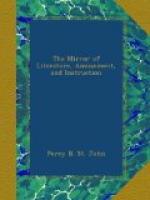Mr. Dovaston visited Bewick, at Buxton, in 1827. Here he relates
“There were three windows in the front room, the ledges and shutters whereof he had pencilled all over with funny characters, as he saw them pass to and fro, visiting the well. These people were the source of great amusement: the probable histories of whom, and how they came by their ailings, he would humorously narrate, and sketch their figures and features in one instant of time. I have seen him draw a striking likeness on his thumb-nail in one moment; wipe it off with his tongue, and instantly draw another. We dined occasionally at the public table; and one day, over the wine, a dispute arose between two gentlemen about a bird; but was soon terminated by the one affirming he had compared it with the figure and description of Bewick, to which the other replied that Bewick was next to Nature. Here the old gentleman seized me by the thigh with his very hand-vice of a grasp; and I contrived to keep up the shuttlecock of conversation playfully to his highest satisfaction, though they who praised him so ardently, little imagined whose ears imbibed all their honest incense.”
Bewick’s observations on the Dove would alone prove him to have been a close observer of nature:
“He said, of all birds he thought the dove tribe most beautiful. Their outline presents every possible variety of the line of beauty; their colours are brilliant and varied; their notes amorous and soothing; their manners gentle and affectionate; their flight both rapid and graceful; and, in all times and nations, they have been emblems of peace, love, and fidelity. They have moreover, many qualities and habits exclusively peculiar to their tribe; they drink differently (by immersion), and have no gall.” The “peace, fidelity, and love” of the Dove have, however, been much questioned by naturalists.
Every one will admire the simplicity of mind and heart in the following opinions of Bewick, in his chat with Mr. Dovaston. Paradise, he said, was of every man’s own making; all evil caused by the abuse of free-will; happiness equally distributed, and in every one’s reach. “Oh!” said he, “this is a bonny world as God made it; but man makes a packhorse of Providence.” He




